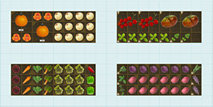How to grow Calendula?
- Latin Family: Asteraceae
- Latin Genus: Calendula
- Ease of Growing: Easy
- Growing Type: Annual
Also known as Pot Marigold, Calendula is an annual with redish, pinkish, orangish, or yellowish creamy blooms. They add sparkle to country-style bouquets and lure visiting summer butterflies. Their edible petals make colorful salad garnishes. Flowers are used as a food color, natural dye, and substitute for saffron. The plant is a prolific self-seeder. The part used is the whole flower, either fresh or dried.
Medicinal: Traditionally used as an anti-inflammatory herb for localized skin problems including insect bites and stings. Reported to activate cellular defense mechanisms. Flowers have MANY other medicinal uses not noted here.
Videos
Calendula History
Native to the Mediterranean. Calendulas have been used for centuries in soothing lotions and salves. The plant used to be used in cooking pots and hence earned the nickname "Pot Marigold". Calendula is a cultigen, meaning that the plant we currently use is the product of ages of human selection (mainly occurring in southern Europe) from the wild Mediterranean ancestor (wild calendula is Calendula arvensis). The plant is a prolific self-seeder. The part used is the whole flower, either fresh or dried. The ancient Romans used the plant for treating scorpion bites and a variety of other medicinal uses.
Soil Preference
- PH (min/max): 4.5 - 8.3
- PH Ideal (min/max): 6.0 - 7.0
Calendula will grow in almost any soil, but prefers a rich, well-drained one.
How to care for Calendula?
Keep soil evenly moist and keep the area well-weeded for the best blooms. Never over-water - soil should never be soggy.
Water
Calendula plants require regular watering but never water so much that the soil becomes soggy.
Fertilizer
Calendula prefers a rich soil but will tolerate poor soils of many types.
Seeds
Seed Viability: 4 - 6 years
Calendula is monecious and has both male and female flowers on the same plant. It's pollinated by bees, but can also self-pollinate.
Calendula seed is an after-ripener. That is, the seed germinates better after 6 months of storage than if planted immediately after maturity. Quality calendula seed is the result of careful selection of the mother plants, combined with great care in the picking, curing, sifting, cleaning and storage of the seed. It produces an abundance of seed and often self-sows in your garden.
Light
Part shade
Calendula can tolerate some shade but prefers full sun.
Conditions:Cool, Warm
Season:Short Season, Long Season
Storage
Bring flowers indoors and out of direct sunlight. Do not wash. Spread the heads out on a dishtowel, newspaper, or drying rack. Turn flowers every so often, and keep out of direct sunlight. Dry flowers for 1 to 5 days until they are crispy and fragile. If using a dehydrator, dry at 90-95˚. Store in an airtight container in a dark placefor up to a year, although the sooner you use them the better.
Storage Req: Drying
Storage Temp: 65-75°F
Storage Length: 180-360 days
Problems
Calendula Types
- Calendula
Also known as Pot Marigold, Calendula is an annual with redish, pinkish, orangish, or yellowish creamy blooms. They add sparkle to country-style bouquets and lure visiting summer butterflies. Their edible petals make colorful salad garnishes. Flowers are used as a food color, natural dye, and substitute for saffron. The plant is a prolific self-seeder. The part used is the whole flower, either fresh or dried.
Medicinal: Traditionally used as an anti-inflammatory herb for localized skin problems including insect bites and stings. Reported to activate cellular defense mechanisms. Flowers have MANY other medicinal uses not noted here.
Pests
- Aphids
- Whiteflies
- Cabbage Looper
- Cabbageworms
- Blister Beetle
- Thrips
- Leafhoppers
- Nematodes
- Slugs and snails
Diseases
- Leaf Blight
- Fungal Leaf Spot
- Mosaic Virus (Several species)
- Bacterial Leaf Spot
- Damping Off
- Bacterial Stem Rot, Bacterial Root Rot, Bacterial Soft Rot
- Powdery Mildew
